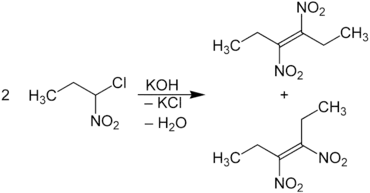特尔·梅尔反应
反应机理
霍索恩1956年根据动力学同位素效应认为决定此反应速率的慢步骤为α-卤代硝基烷在亚硝酸根离子催化下的电离作用,生成碳负离子(2)。接下来,碳负离子发生质子化,产生一个氮酸酯(nitronate)中间体(3)。而后者再经亲核取代反应,氯被硝基取代,得到最终产物。[2]
参见
参考资料
- Edmund ter Meer (1876): Ueber Dinitroverbindungen der Fettreihe. Justus Liebigs Annalen der Chemie 181 (1): 1–22. doi:10.1002/jlac.18761810102.
- M. Frederick Hawthorne: aci-Nitroalkanes. I. The Mechanism of the ter Meer Reaction, J. Am. Chem. Soc.; 1956; 78(19), 4980–4984; doi:10.1021/ja01600a048
- D. E. Bisgrove, J. F. Brown, L. B. Clapp: 3,4-Dinitro-3-hexene, Organic Syntheses, Coll. Vol. 4, p.372 (1963); Vol. 37, p. 23 (1957). (链接 (页面存档备份,存于))
This article is issued from Wikipedia. The text is licensed under Creative Commons - Attribution - Sharealike. Additional terms may apply for the media files.

